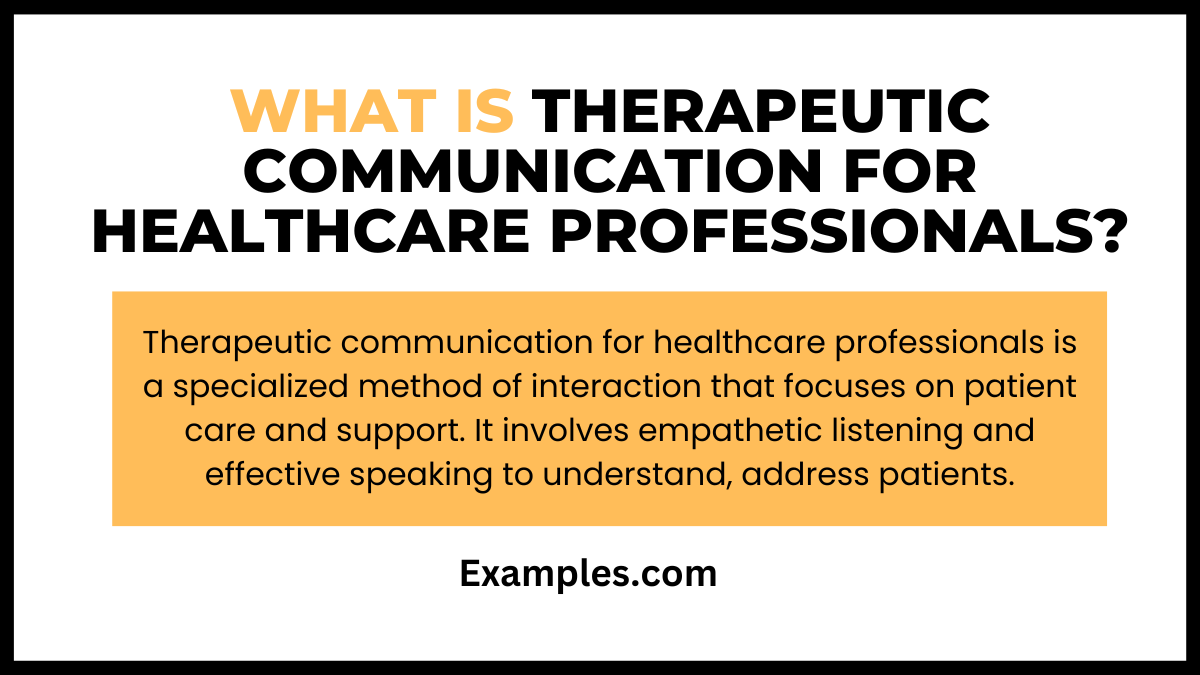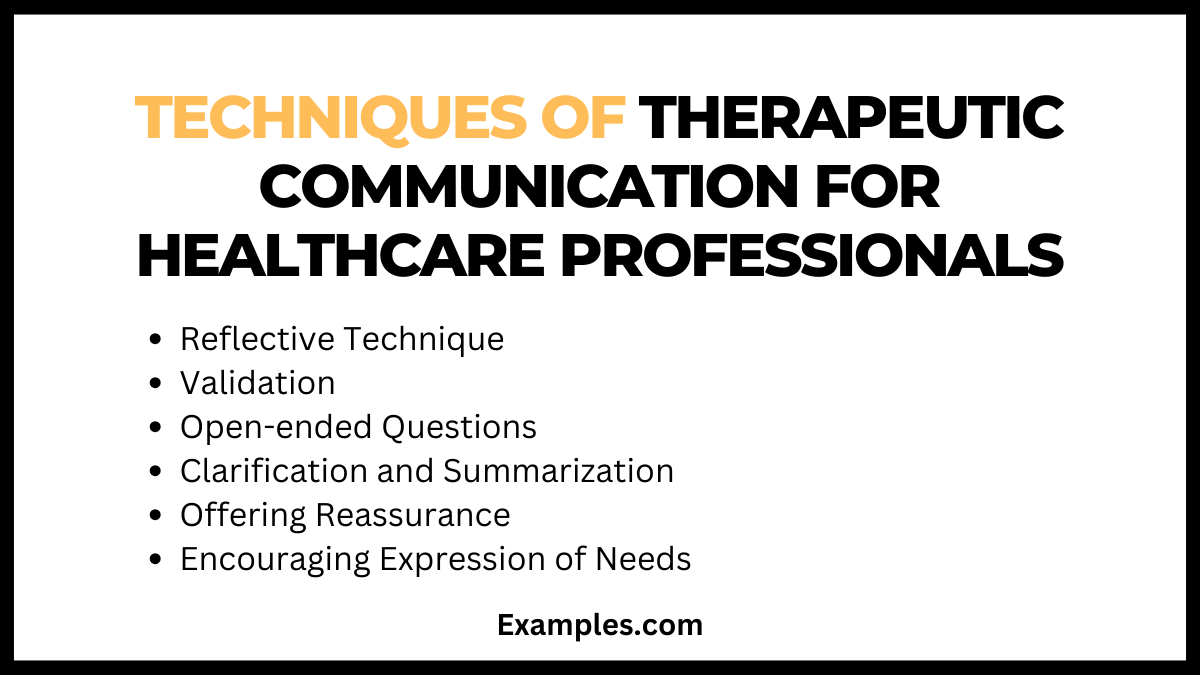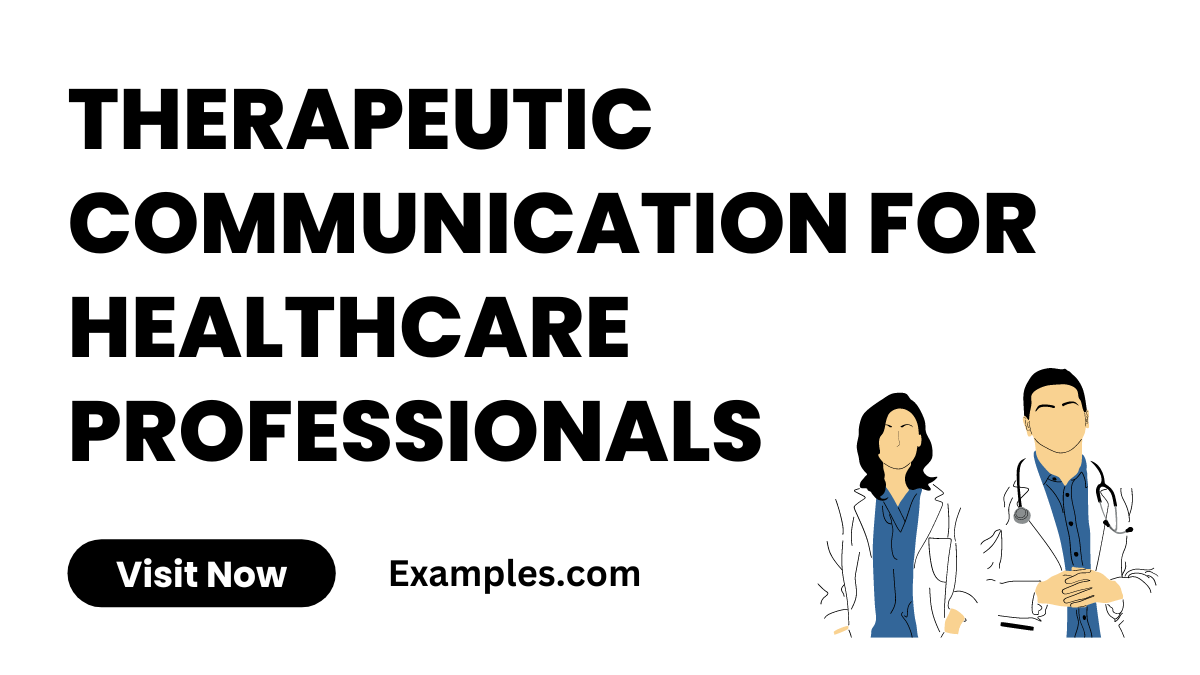10 Therapeutic Communication for Healthcare Professionals Examples
Therapeutic Communication for Healthcare Professionals is a medical communication for patients situation that delves into the nuanced world of patient interaction. This guide provides invaluable insights and examples to equip healthcare workers with the skills needed for effective and empathetic communication. By emphasizing the importance of active listening and empathy, this resource serves as an essential tool for professionals seeking to enhance patient care and build trusting relationships. It covers a range of scenarios, offering practical tips and techniques to ensure that every healthcare conversation is both healing and productive.
What is Therapeutic Communication for Healthcare Professionals?

Therapeutic communication for healthcare professionals is a specialized method of interaction that focuses on patient care and support. It involves using empathetic listening and effective speaking to understand and address patients’ concerns. This communication style is essential in healthcare settings as it helps professionals to build trust with patients, accurately assess their needs, and provide appropriate care. By practicing therapeutic communication, healthcare workers can improve patient outcomes, foster a positive healthcare experience, and support patients’ emotional and psychological well-being.
Therapeutic Communication for Healthcare Professionals in 4th Edition
The 4th Edition of Therapeutic Communication for Healthcare Professionals is a comprehensive resource enriched with contemporary practices and insights. It focuses on enhancing patient interaction and empathy, integrating modern communication technologies and ethical practices. This edition is essential for healthcare professionals seeking to refine their communication skills in a rapidly evolving healthcare environment.
Use of Digital Tools for Patient Education
Digital tools like tablets are used to visually explain medical conditions and treatments, making complex information more understandable.
Telehealth Communication Strategies
Telehealth sessions are optimized with clear guidelines for effective remote patient engagement, bridging the physical distance.
Multilingual Communication Aids
This edition emphasizes the importance of language inclusivity in healthcare, utilizing multilingual aids to cater to diverse patient populations.
Handling Sensitive Health Topics
Strategies for discussing sensitive health issues with patients are outlined, ensuring respect and understanding.
Conflict Resolution in Healthcare Settings
Effective methods for resolving conflicts between healthcare teams and patients are explored, maintaining professionalism and empathy.
Therapeutic Communication for Healthcare Professionals in 5th Edition
The 5th Edition of Therapeutic Communication for Healthcare Professionals marks a significant advancement, focusing on patient-centered care and multicultural competence. This edition is tailored for healthcare professionals to navigate the complexities of modern healthcare communication with sensitivity and effectiveness.
Virtual Reality for Patient Therapy
Innovative use of virtual reality in therapeutic sessions provides immersive experiences for patient education and anxiety reduction.
Cultural Sensitivity Training Modules
Special modules on cultural sensitivity prepare healthcare professionals for diverse patient interactions.
Interactive Patient Feedback Systems
The use of interactive systems for gathering patient feedback enhances understanding of their experiences and needs.
Empathy Training Using Simulation
Simulation scenarios are used for training healthcare professionals in empathy and understanding, enhancing patient relations.
Advanced Non-Verbal Communication Techniques
Advanced techniques in non-verbal communication are outlined to aid in more nuanced patient interactions.
Therapeutic Communication for Healthcare Professionals in Nursing Examples
Therapeutic Communication for Healthcare Professionals in Nursing provides practical examples and scenarios, emphasizing the importance of empathetic and effective communication in nursing. It includes real-world scenarios and best practice guidelines to enhance patient-nurse interactions.
Role-Playing Patient Scenarios
Role-playing exercises are used to simulate real patient interactions, improving nurses’ communication skills in various clinical situations.
Narrative Medicine Techniques
Narrative medicine practices are incorporated, where nurses learn to use storytelling and listening for better patient engagement.
Mindfulness-Based Stress Reduction
Mindfulness techniques are taught to nurses for managing stress and maintaining calmness in patient interactions.
Patient Advocacy Examples
Examples of patient advocacy demonstrate how nurses can effectively represent and communicate patient needs and preferences.
Feedback Loops in Patient Care
Feedback loops between nurses and patients are emphasized for continuous improvement in care and communication.
What are the Essential Components of Therapeutic Communication for Healthcare Professionals?
Therapeutic communication in healthcare is a critical skill that involves various components to ensure effective interaction with patients. This communication style is not just about talking to patients; it’s about connecting with them on a deeper level to understand and meet their needs. The essential components of therapeutic communication include techniques and approaches that foster trust, empathy, and understanding. These elements are crucial in creating a positive healthcare experience for patients and are fundamental in patient care and treatment.
Demonstrating Respect
Showing respect for the patient’s feelings, thoughts, and experiences is fundamental. Respectful interactions ensure that patients feel valued and dignified.
Maintaining Confidentiality
Confidentiality is a key aspect of trust. Healthcare professionals must ensure that all patient information is kept private and secure.
Displaying Cultural Sensitivity
Being sensitive to the cultural backgrounds of patients is essential. This involves understanding and respecting diverse beliefs, values, and customs.
Utilizing Clear and Simple Language
Using language that is easily understandable avoids confusion and ensures that patients comprehend their health status and treatment plans.
Showing Genuine Interest
Expressing genuine interest in the patient’s concerns and life can help build a deeper connection and understanding.
Providing Nonverbal Support
Nonverbal cues such as maintaining eye contact, nodding, and appropriate physical gestures contribute significantly to therapeutic communication.
Encouraging Patient Participation
Inviting patients to participate in discussions about their health and treatment options empowers them and helps them feel more in control.
Offering Emotional Support
Providing emotional support through understanding, compassion, and reassurance is vital, especially in difficult or sensitive situations.
By integrating these essential components into their communication, healthcare professionals can greatly enhance the quality of care and support they offer to their patients, leading to improved health outcomes and patient satisfaction.
What are the Techniques of Therapeutic Communication for Healthcare Professionals?

Therapeutic communication encompasses various methods that healthcare professionals can use to enhance their interaction with patients. These methods aim to ensure that communication is effective, compassionate, and conducive to a healing environment.
Reflective Technique
This involves reflecting on what the patient has said to demonstrate understanding and encourage further communication.
Validation
Acknowledging and validating the patient’s feelings and experiences help in building a connection and making the patient feel valued.
Open-ended Questions
Asking open-ended questions encourages patients to share more information about their feelings and experiences.
Clarification and Summarization
Clarifying and summarizing the patient’s statements ensure that there is mutual understanding between the patient and the healthcare professional.
Offering Reassurance
Providing reassurance to patients, especially in times of stress or uncertainty, is vital in therapeutic communication.
Encouraging Expression of Needs
Facilitating an environment where patients feel comfortable expressing their needs and concerns is important for comprehensive care.
By mastering these communication techniques and methods, healthcare professionals can significantly enhance the quality of care provided, leading to better patient outcomes and satisfaction.
How to Communicate with Patients in Therapeutic Communication for Healthcare Professionals?
Effective communication in therapeutic settings is a cornerstone of healthcare professionalism. This guide focuses on how healthcare professionals can engage in meaningful and empathetic dialogue with their patients. Utilizing therapeutic communication techniques enhances the patient-care experience and fosters trust and understanding. It is not just about the words used, but also how they are delivered, ensuring that patients feel heard, respected, and cared for.
Establishing a Trusting Relationship
Creating a foundation of trust is crucial. This involves being open, honest, and consistent in interactions with patients.
Utilizing Patient-Centered Language
Using patient-centered language that focuses on the patient’s experiences and needs demonstrates empathy and understanding.
Incorporating Active Listening Skills
Active listening involves fully concentrating on the patient’s words, showing understanding, and responding appropriately to their concerns.
Displaying Empathy
Empathy is key in therapeutic communication. It involves acknowledging and understanding the patient’s feelings and experiences.
Being Mindful of Nonverbal Cues
Body language, facial expressions, and tone of voice play a significant role in how messages are conveyed and received.
Providing Clear and Concise Information
Offering information in a manner that is easy to understand ensures that patients are fully informed about their care and treatment.
In conclusion, effective therapeutic communication is a cornerstone in healthcare, vital for building trust, understanding, and fostering patient-centered care. It’s essential to continuously refine these skills to adapt to diverse patient needs and evolving healthcare environments.
Embracing Advancements in Communication Technology:
Modern healthcare settings increasingly incorporate digital tools and telehealth options, offering new avenues for patient interaction. Healthcare professionals should stay informed about these advancements to enhance their communication skills. For further insights, the American Telemedicine Association provides valuable resources and guidelines on telehealth practices.
Cultural Competence and Ethical Practices:
In a world of diverse patient populations, healthcare professionals must cultivate cultural sensitivity and adhere to ethical communication standards. This is crucial for delivering equitable and effective patient care. The National Institutes of Health offers comprehensive resources on cultural competence in healthcare, ensuring professionals are well-equipped to communicate effectively with patients from various backgrounds.
By integrating these aspects, healthcare professionals can significantly elevate the quality and effectiveness of their communication, thereby enhancing patient outcomes and satisfaction.



